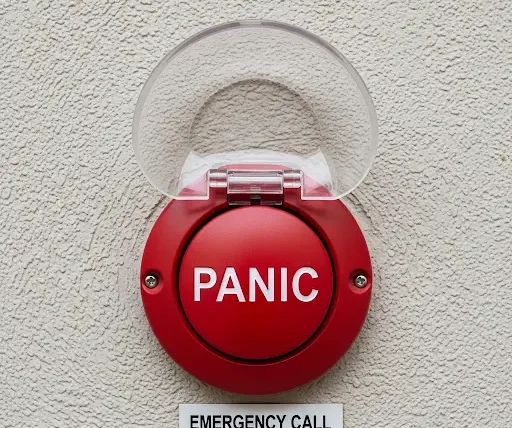
August 7, 2025
In today’s world, safety is not a luxury—it’s a necessity. Whether you’re at home, in the office, or running a business, a panic alarm system can be a lifesaving solution during emergencies. But what exactly is a panic alarm system, how does it work, and what types are available? This blog covers everything you need to know about panic alarm systems to help you make informed decisions for your safety and peace of mind.
What is a Panic Alarm System?
A panic alarm system is a security feature designed to alert authorities or designated personnel when someone is in immediate danger or distress. Unlike traditional alarm systems that detect intrusions, panic alarms are user-activated, often discreet, and intended for emergency situations such as break-ins, medical emergencies, assaults, or robberies. These systems can be installed in homes, hospitals, banks, retail stores, offices, and public spaces—and can also be worn or carried for personal protection.How Does a Panic Alarm System Work?
The system generally includes a trigger device (like a button, wearable device, or mobile app) and a communication channel (wired, wireless, or internet-based) that sends alerts to:- Emergency contacts
- On-site security
- Emergency services or police
- Monitoring centers
Types of Panic Alarm Systems
Here are the major types of panic alarms used in different environments:1. Wired Panic Alarms
- Hardwired to a control system.
- Reliable but requires professional installation.
2. Wireless Panic Alarms
- Easy to install with radio or Wi-Fi signals.
- Portable and suitable for home or mobile use.
3. Manual Push Button Alarms
- Wall-mounted or desk-mounted emergency buttons.
- Common in banks, hospitals, and reception areas.
4. Wearable Panic Alarms
- Wristbands, pendants, or keyfobs.
- Ideal for elderly people, lone workers, or at-risk individuals.
5. Mobile App-Based Alarms
- Panic buttons inside smartphone apps.
- Often includes GPS tracking and alert to emergency contacts.
6. Silent Duress Alarms
- Sends a covert alert without sounding an audible alarm.
- Used in robbery or hostage situations.
7. Foot Pedal Alarms
- Hidden pedal under a desk or counter.
- Allows hands-free activation.
8. Voice-Activated Panic Alarms
- Triggered using preset voice commands.
- Useful for people with limited mobility.
9. Smart Integrated Systems
- Built into home automation systems.
- Controlled via smartphones, smart hubs, or voice assistants.
Key Features to Look For in a Panic Alarm System
When choosing a panic alarm system, consider the following features:- Silent or audible alarm option
- Wireless connectivity
- Battery backup
- Mobile alerts and remote access
- GPS tracking (for wearables and mobile apps)
- Easy installation and maintenance
- 24/7 professional monitoring (optional)
Who Should Use Panic Alarm Systems?
Panic alarm systems are beneficial for:- Homeowners – especially for elderly residents or people with health conditions.
- Lone workers – such as night shift staff or delivery personnel.
- Businesses – including banks, jewelry shops, pharmacies, and retail stores.
- Healthcare facilities – to quickly call for medical assistance.
- Schools & campuses – for student and staff safety during emergencies.
- Women & vulnerable individuals – for personal safety.
Where Can Panic Alarms Be Installed?
- Near beds, especially for elderly users
- Under desks or counters
- Inside bathrooms
- At cash registers
- In entryways and reception areas
- On wearable devices or keychains
Benefits of Panic Alarm Systems
- Immediate response in life-threatening situations
- Discreet and silent options reduce escalation
- Versatile for home, commercial, and mobile use
- Increases peace of mind for individuals and families
- Supports vulnerable or at-risk individuals
- May reduce insurance costs for businesses
Panic Alarm System vs. Regular Security Alarm
| Feature | Panic Alarm | Regular Security Alarm |
|---|---|---|
| Triggered by | Manual activation | Sensors (motion, door, window) |
| Used for | Emergencies, medical, personal threats | Intrusion detection |
| Alert type | Silent or audible | Audible |
| Common in | Homes, businesses, elderly care | Homes, offices |
Conclusion
Panic alarm systems are essential tools for safeguarding your life, property, and loved ones during emergencies. With options ranging from wearable devices to mobile apps and silent alarms, you can choose a system that best fits your lifestyle or business needs. The peace of mind they offer is priceless.FAQs About Panic Alarm Systems
Is a panic alarm system only for businesses?
No. Panic alarm systems are widely used in homes, especially for elderly care or personal safety, as well as businesses and public spaces.
Can I install a panic alarm myself?
Yes, wireless and mobile-based panic alarms are DIY-friendly. However, wired or integrated systems should be installed by professionals.
Is there a monthly fee for panic alarms?
Some systems with professional monitoring require a monthly fee. DIY or app-based alarms may be free or have optional subscriptions.
What happens when I press a panic button?
Depending on the setup, it may trigger a loud alarm, send an SMS/email, or notify a monitoring center or emergency services.
Are panic alarms effective?
Yes, they are highly effective in reducing emergency response times and providing quick assistance in critical situations.
Can panic alarms be connected to the police?
Some systems allow direct communication with local authorities, especially if they are monitored professionally.
Categories: Blog









